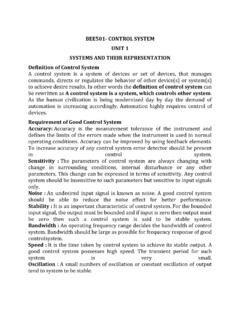Transcription of Digital image processing - Bharath Institute of Higher ...
1 BEC007- Digital image ProcessingUNIT I Digital image FUNDAMENTAL Elements of Digital image processing systems Elements of Visual perception image sampling and quantization Matrix and Singular Value representation of discrete is a Digital image ? A Digital imageis a representation of a two-dimensional image as a finite set of Digital values, called picture elements or Pixel values typically represent gray levels, colours, heights, opacities etc Rememberdigitizationimplies that a Digital image is an approximationof a real scene1 image formats include:1 sample per point (B&W or Grayscale)3 samples per point (Red, Green, and Blue)4 samples per point (Red, Green, Blue, and Alpha , Opacity)For most of this course we will focus on grey-scale imagesWhat is Digital image processing ? Digital image processing focuses on two major tasks Improvement of pictorial information for human interpretation processing of image data for storage, transmission and representation for autonomous machine perception Some argument about where image processing ends and fields such as image analysis and computer vision continuum from image processing to computer vision can be broken up into low-, mid-and high-level processesHistory of Digital image processing Early 1920s: One of the first applications of Digital imaging was in the news-paper industry The Bartlanecable picture transmission service Images were transferred by submarine cable between London and New York Pictures were coded for cable transfer and reconstructed at the receiving end on a telegraph printerHistory of DIP ( ) Mid to late 1920s.
2 Improvements to the Bartlanesystem resulted in Higher quality images New reproduction processes based on photographic techniques Increased number of tones in reproduced imagesImproved Digital imageEarly 15 tone Digital imageHistory of DIP ( ) 1960s:Improvements in computing technology and the onset of the space race led to a surge of work in Digital image processing 1964: Computers used to improve the quality of images of the moon taken by the Ranger 7probe Such techniques were usedin other space missions including the Apollo landingsA picture of the moon taken by the Ranger 7 probe minutes before landingHistory of DIP ( ) 1970s: Digital image processing begins to be used in medical applications 1979:Sir Godfrey N. Hounsfield & Prof. Allan M. Cormack share the Nobel Prize in medicine for the invention of tomography, the technology behind Computerised Axial Tomography (CAT) scansTypical head slice CAT imageHistory of DIP ( ) 1980s -Today:The use of Digital image processing techniques has exploded and they are now used for all kinds of tasks in all kinds of areas image enhancement/restoration Artistic effects Medical visualisation Industrial inspection Law enforcement Human computer interfacesHistory of DIP ( ) 1980s -Today:The use of Digital image processing techniques has exploded and they are now used for all kinds of tasks in all kinds of areas image enhancement/restoration Artistic effects Medical visualisation Industrial inspection Law enforcement Human computer interfacesImage processing Fields Computer Graphics:The creation of images image processing .
3 Enhancement or other manipulation of the image Computer Vision:Analysis of the image contentImage processing FieldsInput / OutputImageDescriptionImageImage ProcessingComputer VisionDescriptionComputer GraphicsAISometimes, image processing is defined as a discipline in which both the input and output of a process are imagesBut, according to this classification, trivial tasks of computing the average intensity of an image would not be considered an image processing operationComputerized Processes Types Low-Level Processes: Inputand outputare images Tasks:Primitive operations, such as, image processing to reduce noise, contrast enhancement and image sharpeningComputerized Processes Types Mid-Level Processes: Inputs, generally, are images. Outputsare attributes extracted from those images (edges, contours, identity of individual objects) Tasks: Segmentation (partitioning an image into regions or objects) Description of those objects to reduce them to a form suitable for computer processing Classifications ( recognition ) of objectsComputerized Processes Types High-Level Processes: image analysis and computer visionDigital image Definition An image can be defined as a two-dimensional function f(x,y) x,y: Spatial coordinate F: the amplitude of any pair of coordinate x,y, which is called the intensity or gray level of the image at that point.
4 X,yand f, are all finite and discrete Steps in Digital image processing : image AcquisitionImage RestorationMorphological ProcessingSegmentationObject RecognitionImage EnhancementRepresentation & DescriptionProblem DomainColour image ProcessingImage CompressionWavelets & Multiresolution processingKnowledge BaseOutputs of these processes generally are imagesOutputs of these processes generally are image attributesFundamental Steps in DIP: (Description)Step 1: image AcquisitionThe image is captured by a sensor (eg. Camera), and digitized if the output of the camera or sensor is not already in Digital form, using analogue-to- Digital convertorFundamental Steps in DIP: (Description)Step 2: image EnhancementThe process of manipulating an image so that the result is more suitable than the original for specific applications. The idea behind enhancement techniques is to bring out details that are hidden, or simple to highlight certain features of interest in an Steps in DIP: (Description)Step 3: image Restoration-Improving the appearance of an image -Tend to be mathematical or probabilistic models.
5 Enhancement, on the other hand, is based on human subjective preferences regarding what constitutes a good enhancement Steps in DIP: (Description)Step 4: Colour image ProcessingUse the colour of the image to extract features of interest in an imageFundamental Steps in DIP: (Description)Step 5: WaveletsAre the foundation of representing images in various degrees of resolution. It is used for image data Steps in DIP: (Description)Step 6: CompressionTechniques for reducing the storage required to save an image or the bandwidth required to transmit Steps in DIP: (Description)Step 7: Morphological ProcessingTools for extracting image components that are useful in the representation and description of shape. In this step, there would be a transition from processes that output images, to processes that output image Steps in DIP: (Description)Step 8: image SegmentationSegmentation procedures partition an image into its constituent parts or Tip: The more accurate the segmentation, the more likely recognition is to Steps in DIP: (Description)Step 9: Representation and Description-Representation: Make a decision whether the data should be represented as a boundary or as a complete region.
6 It is almost always follows the output of a segmentation Representation: Focus on external shape characteristics, such as corners and inflections ( )-Region Representation:Focus on internal properties, such as texture or skeleton ( ) shapeFundamental Steps in DIP: (Description)Step 9: Representation and Description-Choosing a representation is only part of the solution for transforming raw data into a form suitable for subsequent computer processing (mainly recognition )-Description:also called, feature selection, deals with extracting attributes that result in some information of Steps in DIP: (Description)Step 9: recognition and InterpretationRecognition:the process that assigns label to an object based on the information provided by its Steps in DIP: (Description)Step 10: Knowledge BaseKnowledge about a problem domain is coded into an image processing system in the form of a knowledge database.
7 Components of an image processing SystemNetworkImage displaysComputerMass storageHardcopySpecialized image processing hardwareImage processing softwareImage sensorsProblem DomainTypical general-purpose DIP systemComponents of an image processing (Sensor).Thesecond,calledadigitizer, of an image processing System2. Specialized image processing HardwareUsuallyconsistsofthedigitizer,me ntionedbefore,plushardwarethatperformsot herprimitiveoperations,suchasanarithmeti clogicunit(ALU), , , of an image processing , of an image processing System4. image processing ,asaminimum, of an image processing System5. Mass Storage * ,characterizedbyinfrequentaccessComponen ts of an image processing System5. Mass Storage ,calledframebuffers, ,allowsvirtuallyinstantaneousimagezoom,a swellasscroll(verticalshifts)andpan(hori zontalshifts). of an image processing System6. image DisplaysThe displays in use today are mainly color(preferably flat screen) TV monitors.
8 Monitors are driven by the outputs of the image and graphics display cards that are an integral part of a computer of an image processing System7. Hardcopy devicesUsed for recording images, include laser printers, film cameras, heat-sensitive devices, inkjet units and Digital units, such as optical and CD-Rom of an image processing System8. NetworkingIsalmostadefaultfunctioninanyc omputersystem, ,thistypicallyisnotaproblem, of Visual perceptionStructure of the human eye The cornea and sclera outer cover The choroid Ciliarybody Iris diaphragm Lens The retina Cones vision (photopic/bright-light vision): centered at fovea, highly sensitive to color Rods (scotopic/dim-light vision): general view Blind spot45 Human eyeCones vs. RodsHexagonal pixel Models human visual system more precisely The distance between a given pixel and its immediate neighbors is the same Hexagonal sampling requires 13% fewer samples than rectangular sampling ANN can be trained with less errorsCone distribution on the fovea (200,000 cones/mm2)More on the cone mosaicThe cone mosaic of fish retinaLythgoe, Ecology of Vision (1979)Human retina mosaic-Irregularity reduces visual acuity for high-frequency signals-Introduce random noiseThe mosaic array of most vertebrates is regularA mosaickedmultispectral camera50 Brightness adaptation Dynamic range of human visual system 10-6~ 104 Cannot accomplish this range simultaneously The current sensitivity level of the visual system is called the brightness adaptationlevelBrightness discrimination Weber ratio (the experiment) DIc/I I: the background illumination DIc.
9 The increment of illumination Small Weber ratio indicates good discrimination Larger Weber ratio indicates poor discrimination52 Psychovisualeffects The perceived brightness is not a simple function of intensity Mach band pattern Simultaneous contrastImage formation in the eye Flexible lens Controlled by the tension in the fibers of the ciliarybody To focus on distant objects? To focus on objects near eye? Near-sighted and far-sightedImage formation in the eyeLight receptorradiant energyelectrical impulsesBrainA simple image formation model f(x,y): the intensity is called the gray levelfor monochrome image f(x, y) = i(x, y).r(x, y) 0 < i(x, y) < inf, the illumination (lm/m2) 0< r(x, y) < 1, the reflectance Some illumination figures (lm/m2) 90,000: full : black velvet 10,000: cloudy : snow : full moon 1,000: commercial officeCamera exposure ISO number Sensitivity of the film or the sensor Can go as high as 1,600 and 3,200 Shutter speed How fast the shutter is opened and closed f/stop The size of aperture ~ 32 Sampling and QuantizationUniform sampling Digitized in spatial domain (IM x N) M and N are usually integer powers of two Nyquisttheorem and Aliasing Non-uniform sampling communication(0,0)(0,1)(0,2)(0,3)(1,0)(3 ,0)(2,0)(1,1)(2,1)(3,1)(2,2)(3,2)(1,2)(3 ,3)(2,3)(1,3)(0,0)(0,0)(0,2)(0,2)(0,0)(2 ,0)(2,0)(0,0)(2,0)(2,0)(2,2)(2,2)(0,2)(2 ,2)(2,2)(0,2)Sampledby 259 More on aliasing Aliasing (the Moireeffect)originalSampled by 2 Sampled by 4 Sampled by 8 Sampled by 16 Uniform quantization Digitized in amplitude (or pixel value) PGM 256 levels 4 levels0255641281920312original128 levels (7 bits)16 levels (4 bits)4 levels (2 bits)2 levels (1 bit)
10 image resolution Spatial resolution Line pairs per unit distance Dots/pixels per unit distance dots per inch -dpi Intensity resolution Smallest discernible change in intensity level The more samples in a fixed range, the Higher the resolution The more bits, the Higher the resolution3D interpretation of line drawing Emulation approach Agiven3-Dinterpretationisconsideredlessl ikelytobecorrectifsomeanglesbetweenthewi resaremuchlargerthanothersRepresenting Digital imagesEvery pixel has a # of image Representation Coordinate Conventions The result of sampling and quantization is a matrix of real numbers There are two principle ways to represent a Digital image : Assume that an image f(x,y)is sampled so that the resulting image has Mrows and Ncolumns. We say that the image is of size M xN. The values of the coordinates (x,y) are discrete quantities. For clarity, we use integer values for these discrete coordinates.

















